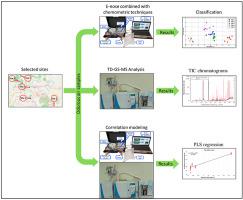Atmospheric Environment ( IF 4.2 ) Pub Date : 2021-05-01 , DOI: 10.1016/j.atmosenv.2021.118449 Mohammed Moufid , Benachir Bouchikhi , Carlo Tiebe , Matthias Bartholmai , Nezha El Bari

|
Poor air quality, particularly in urban areas, causes various diseases and degrades living standards. Air quality could be affected by emissions of odor, Volatile Organic Compounds (VOCs), and other gases. Therefore, assessment and monitoring of odorous air quality using sensitive, simple, rapid, accurate and portable tools is very important for public health. This study aimed to characterize odor emissions to detect malfunctions in facilities and to prevent air pollution and olfactory nuisance in the environment. A gas chromatographic method, in conjunction with sensorial analysis were performed for odorous air samples analysis collected from neighborhood of Meknes city (Morocco). Advanced multivariate statistical approaches, such as Principal Components Analysis (PCA), Discriminant Function Analysis (DFA), Support Vector Machines (SVMs), and Hierarchical Cluster Analysis (HCA), were used to describe samples similarities. The electronic nose (e-nose) data processing exhibits a satisfactory discrimination between the odorous air samples. Twenty-four VOCs with known molecular formulas were identified with Thermal Desorption-Gas Chromatography-Mass Spectrometry (TD-GC-MS). A validated Partial Least Square (PLS) model foresees good calibration between e-nose measurement and TD-GC-MS analysis. The finding indicates that TD-GC–MS approach in conjunction with e-nose unit could be suitable tool for environmental measurement-based odor emissions.
中文翻译:

使用同时热脱附-气相色谱-质谱(TD-GC-MS),电子鼻和先进的多元统计方法评估污染场地的室外气味排放
空气质量差,尤其是在城市地区,会导致各种疾病并降低生活水平。空气质量可能会受到气味,挥发性有机化合物(VOC)和其他气体排放的影响。因此,使用灵敏,简单,快速,准确和便携式的工具评估和监测有气味的空气质量对于公共卫生非常重要。这项研究旨在表征气味的排放,以检测设施中的故障,并防止环境中的空气污染和嗅觉滋扰。结合气相色谱法和感官分析,对从梅克内斯市(摩洛哥)附近收集的有味空气样品进行了分析。先进的多元统计方法,例如主成分分析(PCA),判别函数分析(DFA),支持向量机(SVM),和层次聚类分析(HCA)用于描述样本的相似性。电子鼻(电子鼻)数据处理在有气味的空气样本之间表现出令人满意的区别。用热脱附-气相色谱-质谱法(TD-GC-MS)鉴定了二十四个具有已知分子式的VOC。经过验证的偏最小二乘(PLS)模型预示了电子鼻测量和TD-GC-MS分析之间的良好校准。研究结果表明,TD-GC-MS方法与电子鼻装置配合使用可能是基于环境测量的气味排放的合适工具。用热脱附-气相色谱-质谱法(TD-GC-MS)鉴定了二十四个具有已知分子式的VOC。经过验证的偏最小二乘(PLS)模型预示了电子鼻测量和TD-GC-MS分析之间的良好校准。研究结果表明,TD-GC-MS方法与电子鼻装置配合使用可能是基于环境测量的气味排放的合适工具。用热脱附-气相色谱-质谱法(TD-GC-MS)鉴定了二十四个具有已知分子式的VOC。经过验证的偏最小二乘(PLS)模型预示了电子鼻测量和TD-GC-MS分析之间的良好校准。研究结果表明,TD-GC-MS方法与电子鼻装置配合使用可能是基于环境测量的气味排放的合适工具。











































 京公网安备 11010802027423号
京公网安备 11010802027423号